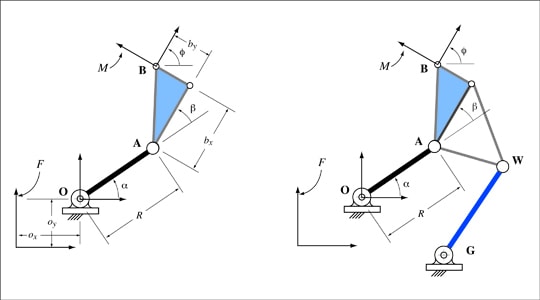Kinematic Synthesis of Mechanisms
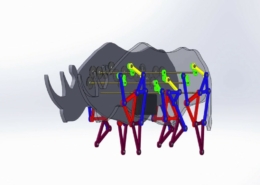
Six-Legged Mechanical Walkers: Spring 2020 Highlights

Prototype Four-Legged Mechanical Walker
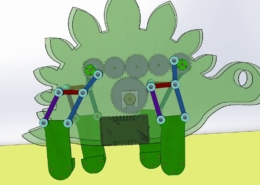
Four-Legged Mechanical Walkers: Spring 2020 Highlights
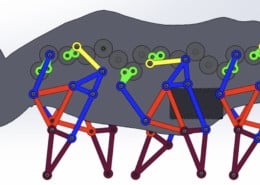 MDA
MDAThe Design of Mechanical Walkers: Spring 2020 Student Projects

Fall 2019 Mechanical Walker Prototypes
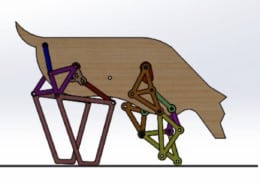 MDA
MDAFour-legged Mechanical Walkers: Teams 2, 4 and 5
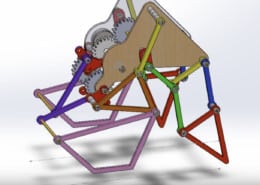 MDA
MDAFour Legged Mechanical Walker: Teams 1, 3 and 6

Halloween Display 2019

More Halloween Linkage Designs
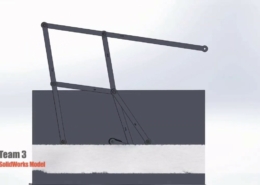
Halloween Design Project
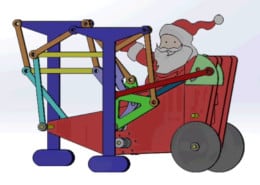
Mechanical Walker Project Animations: Spring 2019

Leg Mechanism for a Mechanical Walker

Construction for Three-Position Synthesis of a Four-Bar Linkage

Five Position Synthesis of Four-bar Function Generators
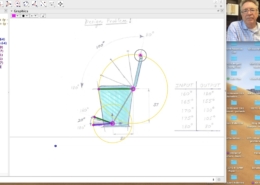
Construction for Two-Position Synthesis of a Four-Bar Linkage
Machine Design

Instruments for Natural Philosophy
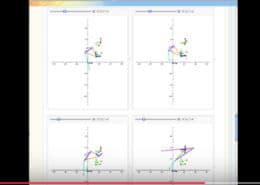
Linkage Synthesis Demonstration
Technical information for mechanical components
 https://mechanicaldesign101.com/wp-content/uploads/2009/07/carbibles.com1.jpg
238
800
Prof. McCarthy
https://mechanicaldesign101.com/wp-content/uploads/2016/07/mechanical-design-101LOGOf.png
Prof. McCarthy2009-07-29 05:08:202022-07-08 19:31:41Automotive components
https://mechanicaldesign101.com/wp-content/uploads/2009/07/carbibles.com1.jpg
238
800
Prof. McCarthy
https://mechanicaldesign101.com/wp-content/uploads/2016/07/mechanical-design-101LOGOf.png
Prof. McCarthy2009-07-29 05:08:202022-07-08 19:31:41Automotive componentsParallel Mechanisms information center
Mechanical Properties of Steel

Unified Numbering System for Materials
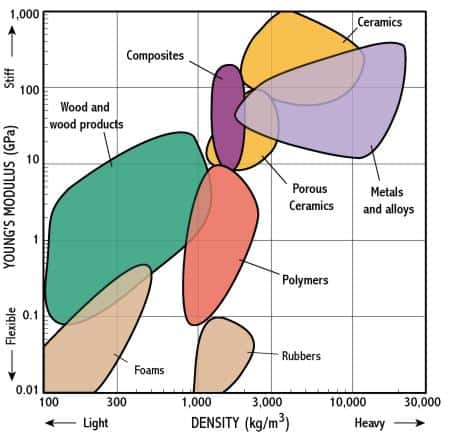 https://mechanicaldesign101.com/wp-content/uploads/2009/07/genericmaterials.jpg
441
476
Prof. McCarthy
https://mechanicaldesign101.com/wp-content/uploads/2016/07/mechanical-design-101LOGOf.png
Prof. McCarthy2009-07-07 16:30:212017-01-05 22:50:31Material Properties Charts
https://mechanicaldesign101.com/wp-content/uploads/2009/07/genericmaterials.jpg
441
476
Prof. McCarthy
https://mechanicaldesign101.com/wp-content/uploads/2016/07/mechanical-design-101LOGOf.png
Prof. McCarthy2009-07-07 16:30:212017-01-05 22:50:31Material Properties Charts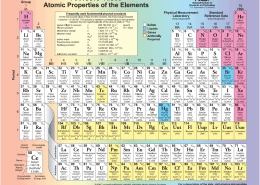 https://mechanicaldesign101.com/wp-content/uploads/2009/07/Periodic-Table.png
1238
1600
Prof. McCarthy
https://mechanicaldesign101.com/wp-content/uploads/2016/07/mechanical-design-101LOGOf.png
Prof. McCarthy2009-07-06 16:48:102017-01-05 22:58:35NIST Periodic Table
https://mechanicaldesign101.com/wp-content/uploads/2009/07/Periodic-Table.png
1238
1600
Prof. McCarthy
https://mechanicaldesign101.com/wp-content/uploads/2016/07/mechanical-design-101LOGOf.png
Prof. McCarthy2009-07-06 16:48:102017-01-05 22:58:35NIST Periodic Table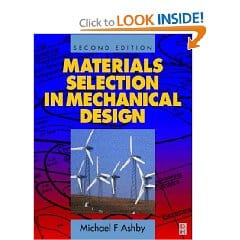
Materials Selection in Mechanical Design
Lecture Notes
 https://mechanicaldesign101.com/wp-content/uploads/2010/12/Spherical-Fourbar.jpg
283
399
Prof. McCarthy
https://mechanicaldesign101.com/wp-content/uploads/2016/07/mechanical-design-101LOGOf.png
Prof. McCarthy2010-12-15 08:08:202017-01-07 22:35:50Spherical Four-Bar Linkages
https://mechanicaldesign101.com/wp-content/uploads/2010/12/Spherical-Fourbar.jpg
283
399
Prof. McCarthy
https://mechanicaldesign101.com/wp-content/uploads/2016/07/mechanical-design-101LOGOf.png
Prof. McCarthy2010-12-15 08:08:202017-01-07 22:35:50Spherical Four-Bar Linkages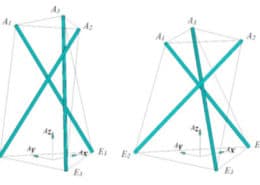 https://mechanicaldesign101.com/wp-content/uploads/2010/11/21st-Century-Kinematics.jpg
342
607
Prof. McCarthy
https://mechanicaldesign101.com/wp-content/uploads/2016/07/mechanical-design-101LOGOf.png
Prof. McCarthy2010-11-12 03:10:572017-01-07 22:40:4221st Century Kinematics
https://mechanicaldesign101.com/wp-content/uploads/2010/11/21st-Century-Kinematics.jpg
342
607
Prof. McCarthy
https://mechanicaldesign101.com/wp-content/uploads/2016/07/mechanical-design-101LOGOf.png
Prof. McCarthy2010-11-12 03:10:572017-01-07 22:40:4221st Century Kinematics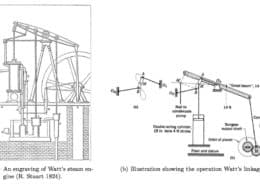
Kinematics, Polynomials and Computers–A Brief History

Mathematica Notebook for Four-Bar Linkage Synthesis

Cam-driven artist mechanical toy
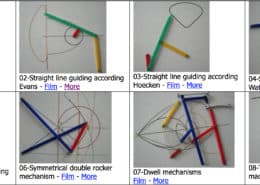
Linkage models at TU-Delft
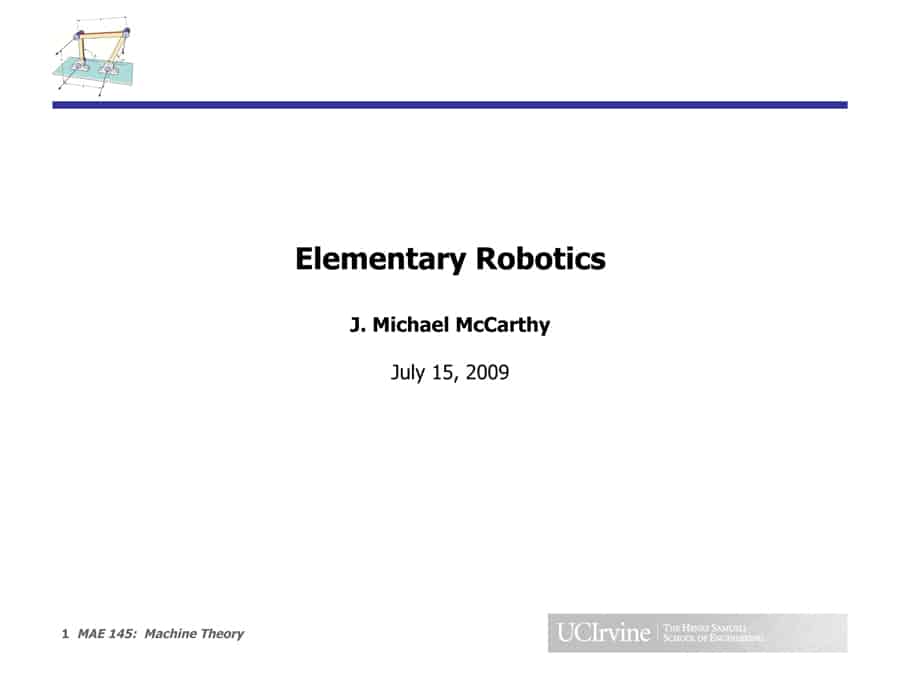 https://mechanicaldesign101.com/wp-content/uploads/2009/07/McCarthyNotes-5cover.jpg
675
900
Prof. McCarthy
https://mechanicaldesign101.com/wp-content/uploads/2016/07/mechanical-design-101LOGOf.png
Prof. McCarthy2009-07-16 04:07:532017-01-08 08:59:28Elementary Robotics
https://mechanicaldesign101.com/wp-content/uploads/2009/07/McCarthyNotes-5cover.jpg
675
900
Prof. McCarthy
https://mechanicaldesign101.com/wp-content/uploads/2016/07/mechanical-design-101LOGOf.png
Prof. McCarthy2009-07-16 04:07:532017-01-08 08:59:28Elementary Robotics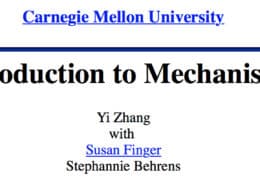
CMU’s Introduction to Mechanisms
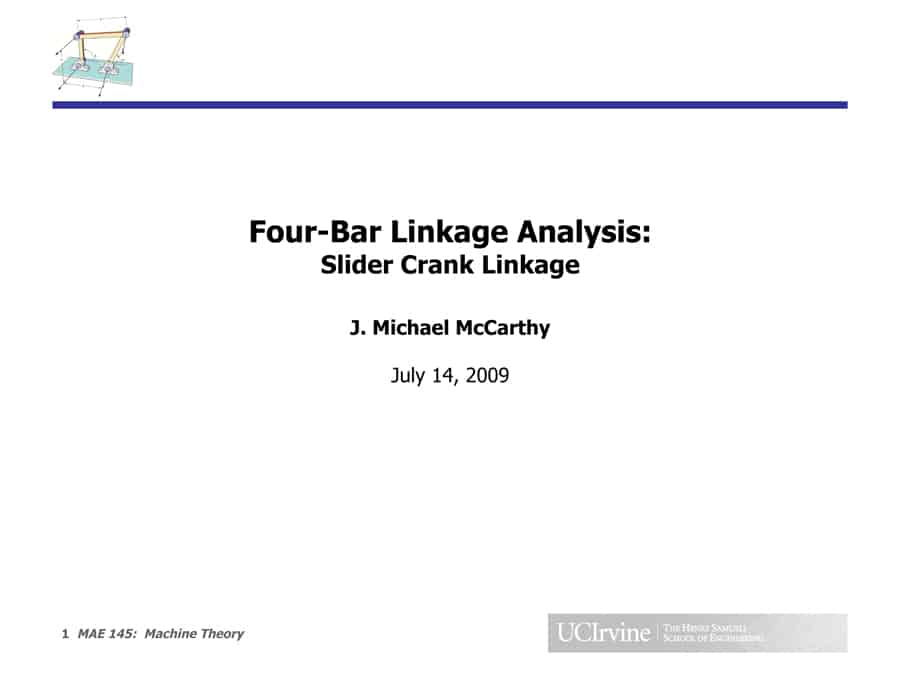
Four-bar linkage analysis: Slider-crank
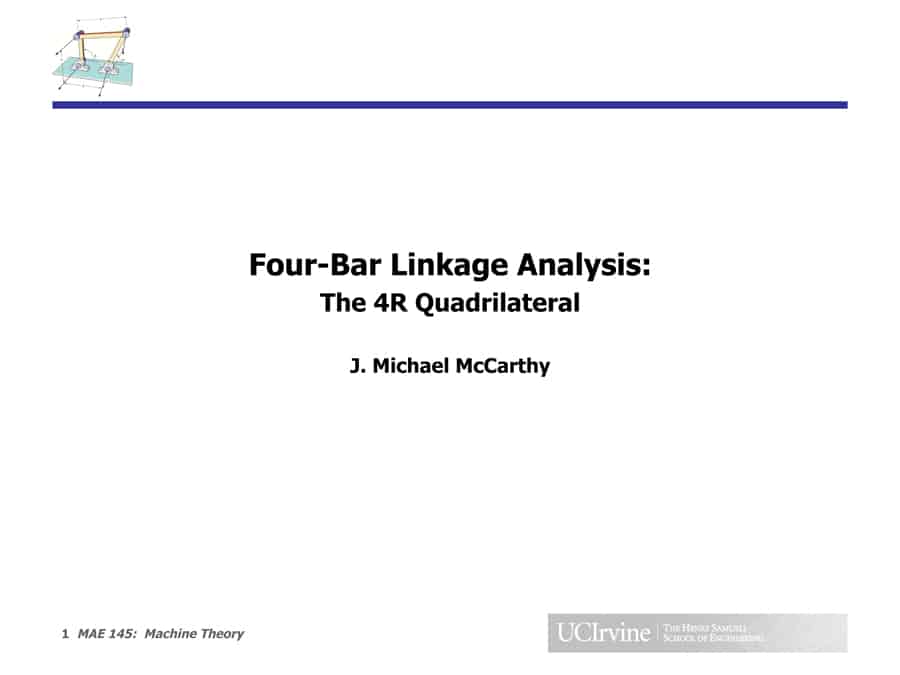
Four-bar linkage analysis: 4R quadrilateral
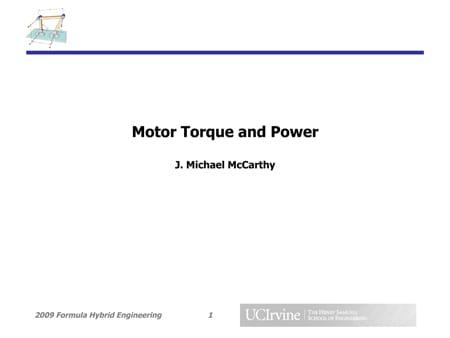
DC motor torque and power
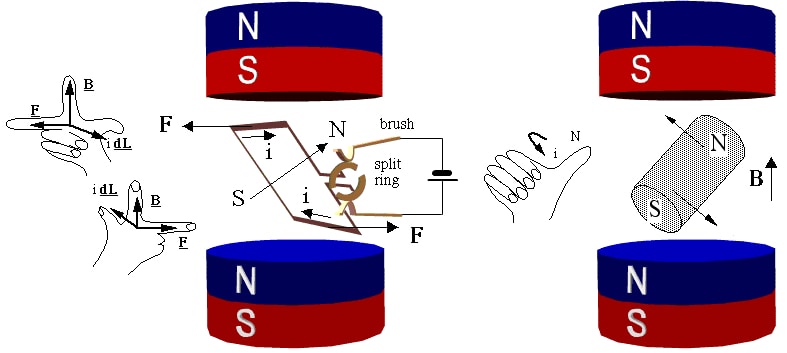 https://mechanicaldesign101.com/wp-content/uploads/2009/07/phyclips.jpg
353
787
Prof. McCarthy
https://mechanicaldesign101.com/wp-content/uploads/2016/07/mechanical-design-101LOGOf.png
Prof. McCarthy2009-07-11 21:49:362017-01-08 09:30:22DC motor basics
https://mechanicaldesign101.com/wp-content/uploads/2009/07/phyclips.jpg
353
787
Prof. McCarthy
https://mechanicaldesign101.com/wp-content/uploads/2016/07/mechanical-design-101LOGOf.png
Prof. McCarthy2009-07-11 21:49:362017-01-08 09:30:22DC motor basics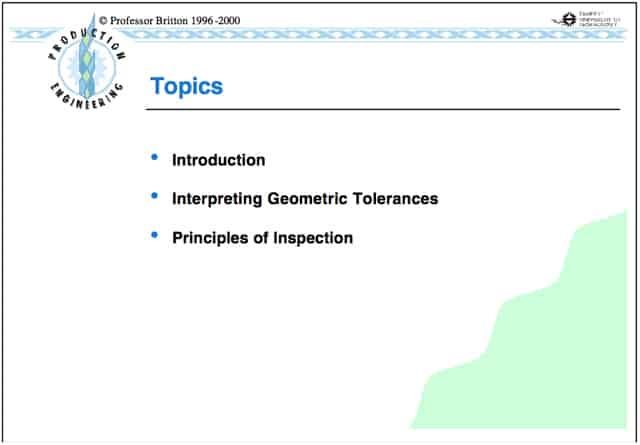
Geometric Dimensioning and Tolerancing

C. J. Sangwin’s linkage movies
Brock Engineering’s mechanism home page
Have a linkage design challenge? We can help.
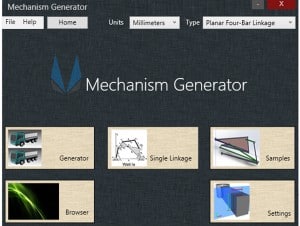 Contact us on this feedback form. We look forward to providing our MechGen synthesis software to simplify your linkage design process in SolidWorks.
Contact us on this feedback form. We look forward to providing our MechGen synthesis software to simplify your linkage design process in SolidWorks.
Linkage Synthesis Theory
The mathematical synthesis of linkage movement provides a powerful tool for invention. However, the specified task may not have useful solutions, and the search for successful tasks can be discouraging.
To address this, we automate the search and evaluation process within tolerance zones specified by the designer. These Mathematica notebooks implement our approach to finding defect-free four-bar linkage designs.
RR Constraint Synthesis for Function Generation
Synthesis of an RR Constraint
An important technique in kinematic synthesis is the design of an RR constraint that controls the movement of two joints of an existing serial chain. For a given RR serial chain, like OA shown above, we can specify its movement through five required task positions. This provides the information needed to design an RR constraint, GW above, that ensures the system moves through the required task positions.
This technique is called function generation in the kinematics synthesis literature, because the synthesized RR constraint maintains a specified relationship between the joint angles alpha and beta at joints O and A.
Select this link to download our Mathematica notebook: RR-Constraint Synthesis. It uses a given RR chain and the associated task to determine tolerance zones, where it searches for defect-free designs. As above, this file may download as text file so remove the .txt extension, then it should be readable by Mathematica. If you have any questions, please contact me.
Five-Position Synthesis of a Four-bar Linkage
Here we show a four-bar linkage designed to guide the coupler through five required task positions.
Please download and try our updated Mathematica notebook: Five-Position Synthesis. It searches in the vicinity of the required task for sets of positions that yield defect-free four-bar linkages. It may download as textfile so remove the .txt extension, then it should be readable by Mathematica.
The video below shows the operation of this notebook.
If you have any problems or advice, please contact me.

